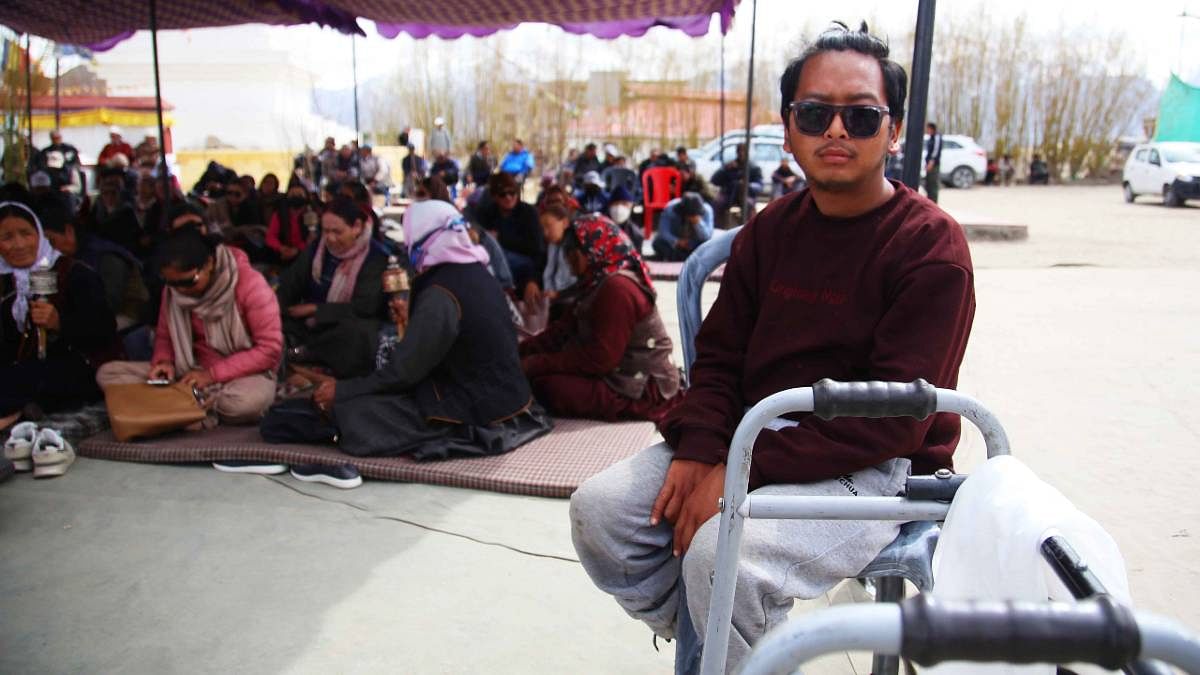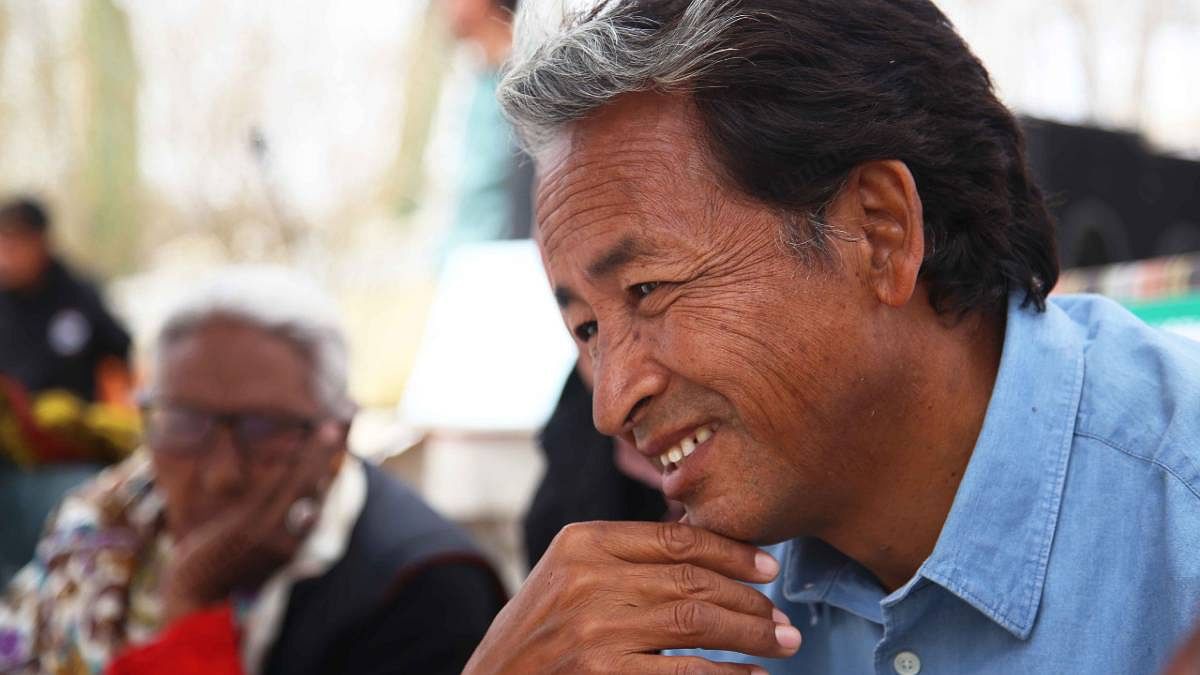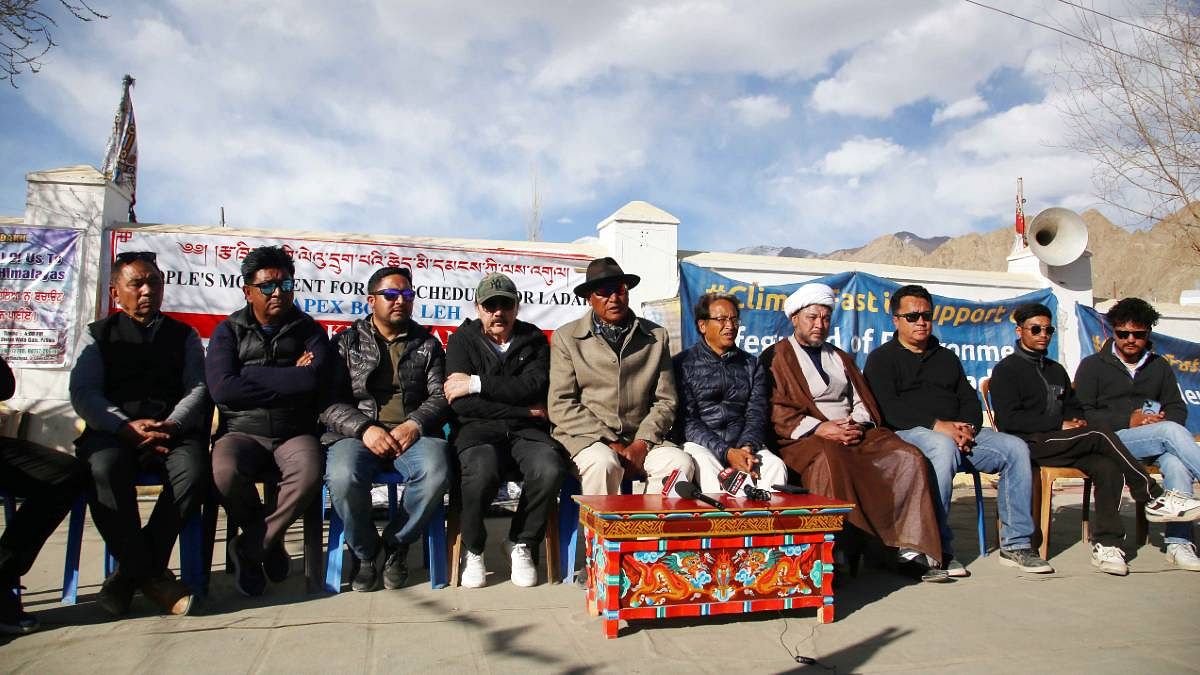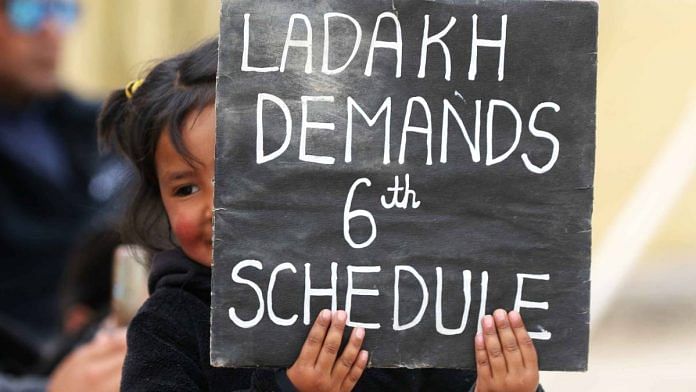Leh: Seated in the front row of a crowd, braving the harsh sun at Leh’s Martyr’s Ground, and muttering something to himself is 23-year-old Rafail who has 85 percent disability. His gaze remains fixed on a poster proclaiming the demand for “statehood”.
For the last two weeks, he has not gone home, has been sleeping in -1 degree Celsius temperature at the protest site and has undertaken a six-day hunger strike. He is scared about his future, he says.
“This is the time of war. If I don’t sit here to speak about the issue of joblessness and suppression of our autonomy, I would not be doing justice to myself and my homeland. I am fighting for myself and thousands of other youngsters whose future is in the dark.”

Alongside him is 87-year-old Yangchan Dolma, who doesn’t belong to any political party but faithfully arrives at the protest site each morning at 8 am, steadfastly remaining until nightfall. She asserts that she has been an activist since she was 16 and her life is devoted to Ladakh and its fight for identity, land, environment, and democratic principles.
These two individuals represent just a fraction of the many protesters who have been united in their demand for Ladakh’s autonomy and have been sitting since the first week of March this year at the Martyr’s Ground with Sonam Wangchuk, an environmentalist and engineer, who ended a 21-day hunger strike on 26 March.

Among the gathering, there is a prevailing sentiment that the BJP-led central government did not fulfil the promise of inclusion of Ladakh in the Sixth Schedule, that the party made in its manifesto ahead of the 2019 Lok Sabha polls, as well as the Ladakh council polls of 2020, leaving the region vulnerable to the whims of “outside” authorities who lack understanding of the region’s needs.
The Sixth Schedule empowers tribal communities with a degree of autonomy in governance, enabling them to manage their own affairs and resources. Tribals are estimated to make up more than 90 percent of the population in Ladakh.
Another concern is Ladakh’s fragile ecology that can be severely impacted by an influx of industries, setting up of solar plants, hydropower projects and mining projects, once it is thrown open for all.
The transition of Ladakh into a Union Territory (UT), following the abrogation of Article 370 in 2019 and bifurcation of the erstwhile state of Jammu and Kashmir (of which Ladakh was previously a part), initially elicited celebrations among residents as they had always accused the J&K leadership of being discriminatory and ignorant towards their region.
With Ladakh becoming a UT, residents expected better administration, representation in Parliament, access to government funds and resources, and a heightened focus on development. But soon after the central government declared Ladakh a UT without a legislature, voices in the region began to rise in protest demanding autonomy, jobs and safeguards for their land and culture, leading to a full-blown protest with over 20,000 people joining Wangchuk in his hunger strike last month.
Further, local leaders allege that a shift in power dynamics, wherein authority previously vested in the Ladakh Autonomous Hill Development Councils (LAHDC, elected every five years) was transferred to civil servants and the Lieutenant Governor (L-G), disempowered local bodies, fostering a sentiment of being governed directly from Delhi.
Moreover, breakdown of negotiations on these demands being held by two umbrella outfits — Leh Apex Body (LAB) and Kargil Democratic Alliance (KDA) along with members of the LAHDCs from both Leh and Kargil — with the Ministry of Home Affairs (MHA) further exacerbated a sense of alienation, fuelling greater discontentment.
“Earlier, the bureaucracy used to sit in Jammu or Srinagar and now they are at our door. They are not clearing the files, obstructing our work as even in minor issues clearances are required from the L-G and his office, which was never the case earlier. It has been more than five years since we became a UT, but till now they have not yet created rules for recruitment of gazetted employees. Is all this for our benefit? If this is what a UT is, we do not want it,” Chering Dorjay Lakruk, a senior member of LAB, tells ThePrint.
According to a source in the UT administration, the government was keen to resolve the issue with the Ladakhis and also gave them an option of granting them safeguards under Article 371, which includes special provisions for 11 states, along with further empowering the local councils, but the leadership rejected the same, leading to a deadlock.
The source said the government had also conveyed to the leadership that the Sixth Schedule might, in principle, give greater autonomy on the face of it, but it comes with challenges. For instance, autonomous district councils under the Sixth Schedule have to generate their own revenue, while right now the LAHDCs receive Rs 300 crore each for development activities from the central government.
“At the local level a perception is being created that the government will take away land, which is wrong as the power of land is vested with the hill councils. The government is very keen to resolve the issue and is willing to go the extra mile. They were offered safeguards under Article 371, which will give them more powers than the Sixth Schedule, and which includes protection of land and culture, but they rejected the same,” the source explained.
Despite protests for these demands ongoing for over a year, and demonstrations being held across different parts of the UT, the current surge in support, particularly behind Wangchuk, is attributed to the Lok Sabha elections. Many believe that it is an opportune time for voices to be heard, recognising that it is during election season that governments are more attuned to the demands of the electorate.
“This time is crucial. Once elections are over, they don’t have to worry for five more years. After this, no one would care about people living on the other side of the mountains. That is why we will continue to make our voice heard,” Wangchuk tells ThePrint.
On the government’s offer to grant safeguards to Ladakh under Article 371, Wangchuk added: “Article 371 gives special provisions to areas within specific states. It is a meaningless thing without a state legislature. It’s a hoax. If the government really meant business, it would have given us (provisions under Article) 371A or G, like in Nagaland or Mizoram, that too together with a legislative assembly, then we could have considered it.”
“But they just want to mislead people by showing this lollipop. It means nothing.”
Also Read: Ladakh protest for Sixth Schedule has hit an impasse. Govt should propose middle ground
Changing power dynamics
Central to the agitation in Ladakh are four pivotal demands.
First, the inclusion of Ladakh under the Sixth Schedule of Article 244 of the Constitution, which provides for the formation of autonomous administrative divisions that have some legislative, judicial, and administrative autonomy within a state, crucial for safeguarding the interests and culture of tribal populations along with protection of Ladakh’s ecology.
Second, full statehood for Ladakh or at least recognition of it as a UT with a state legislature which would allow the people of Ladakh to elect their representatives.
Third, establishment of a distinct Public Service Commission with 80 percent of reservation, and fourth, two separate Lok Sabha seats, one each for Leh and Kargil.
Ladakh has a distinct setup where two councils — Ladakh Autonomous Hill Development Council (Leh) led by the BJP and Ladakh Autonomous Hill Development Council (Kargil) led by the National Conference and Congress — run the local administration. Key officials including the District Commissioner report to these councils.

Each of the two LAHDCs, which hold elections every five years, has 30 councillors (26 elected and four nominated) and they have been vested with powers, including allotment of state land known as khalsa to either private entities or government bodies, and key decisions on forest, education and healthcare, all of which is mentioned in the LAHDC Act of 1997.
Although the councils do not have legislative powers, they can make by-laws, rules and regulations with regard to the subjects mentioned in the Act.
These councils operate like any state government, where the Chief Executive Councillor (CEC) is like the chief minister and his four executive councillors are his cabinet.
With Ladakh becoming a UT and the L-G now clearing major decisions, the LAHDCs are complaining of “erosion of their powers”.
“Now the governor and his secretaries who sit at the secretariat hold all powers. A new power centre has come up over us and they have diluted the powers we had,” Dr Mohammad Jaffer Akhoon, CEC of LAHDC (Kargil), tells ThePrint.
He said that before Ladakh became a UT, power to allot and lease out land, transfer and posting of district level officers, executive decisions on education and health, all rested with the council, but now clearances were required from the top bureaucracy for everything.
“Every decision we make now requires clearance from the L-G’s office, be it a decision to allot a land parcel or make transfers or post officials reporting to us. Even for the level of a peon, transfers are being decided by the L-G’s office,” said Akhoon.
According to LAHDC officials, one of their key powers to allot land now remains “only on paper”.
Once the council allots land to either an individual or group for an upcoming project, it conveys it to the District Collector who then issues an order. But for the last three years, both councils have done many such allotments, all of which are now stuck over “final clearance” from the L-G’s office, the officials claimed.
Referring to one such incident, Lakruk recounted a longstanding dispute over the restoration of a Buddhist monastery in Kargil, which had persisted for decades between the councils in Kargil (with a Muslim majority) and Leh (with a Buddhist majority).
When the council in Leh sought the allocation of land for a temple, the Kargil council was initially resistant. However, just a year ago, the Kargil council not only issued orders for the restoration of the temple but also designated separate land for the construction of another.
Lakruk claimed that this file has remained pending clearance in the L-G’s office for an extended period.
Interestingly, the fight for Ladakh’s autonomy has brought Leh and Kargil on the same page. The two districts have historically harboured differences and seen incidents of communal violence. However, after decades, the demands for Sixth Schedule and statehood have brought the councils onto the same page.
“We had differences over several issues including that of identity, development and funds but we have come together because this is a ‘struggle for Ladakh’s existence’. We have kept aside our differences, and are on the same page as far as the demands are concerned,” Sajjad Hussain, leader of KDA, tells ThePrint.
“We managed to resolve a longstanding dispute, and the council in Kargil allocated land for the temple. However, despite our efforts, the file is yet to receive clearance from the L-G’s office. We are making allocations, but the District Commissioner is withholding the orders. With files accumulating at the secretariat, the question arises: what is the value of this purported power? It is only on paper,” he said.
Speaking about the allegations, an officer from the Ladakh administration tells ThePrint that “Ladakh is undergoing a transition after it became a UT and the administration is working hard to ensure that all issues such as rules for recruitment of gazetted posts are sorted out at the earliest”.
“Moreover, it is not true that files are stuck at the L-G office. A process to clear these files is being followed,” the officer added.
‘Lack of jobs, lapsable funds’
A significant issue that has become a concern for all is the sharp rise of unemployment in Ladakh.
Since Ladakh became a UT, no recruitment for gazetted posts, which was earlier done under the J&K Public Service Commission (JKPSC), has been undertaken. Since it is still not clear as to under which PSC Ladakh will fall, the rules of recruitment have not been framed.
While students who had been preparing for competitive exams term it a major setback to their aspirations and careers, officials in the Ladakh administration say they are working to “resolve the problem”.
According to a response to a question in Parliament, unemployment in Ladakh rose between 2021 and 2023 with a jump of 16 percent each year. Apart from the hill territory, unemployment among graduates also rose in Puducherry, Andaman and Nicobar Islands, Dadra and Nagar Haveli, Daman and Diu, the labour ministry said.
Speaking to ThePrint, Ahmed Qadire, president of Students Education Movement of Kargil, said the setback “ruined the lives of youngsters”.
“Each year, students hope that the gazetted posts will open and an exam will be conducted but they are disappointed. In the last five years, the government has not even been able to make rules for recruitment. They have not yet decided which PSC we will fall under and how recruitments will be done,” Qadire added.
“We are losing valuable time but the government is apathetic towards our sufferings. The youngsters are very frustrated,” he tells ThePrint.

Lakruk said that during negotiations with the Ministry of Home Affairs, this was a key issue which was discussed and the government has now agreed to give Ladakh a separate PSC.
He added that the LAB and KDA leadership asked for 80 percent reservation for Ladakhis in that PSC, fearing that people from other states may eat into their share.
“The government has agreed to a Public Service Commission for Ladakh. They told us that they can give us 45 percent reservation for Ladakhis in that, but we require 80 percent. They have now asked us to wait for three months,” he said.
According to the Ladakh administration, recruitment for gazetted officers was earlier done through the JKPSC but after Ladakh became a UT, it was stopped.
Government data, however, shows the UT’s administration completed recruitment for 1,033 posts of various categories through various recruitment agencies.
Speaking to ThePrint, Deputy Commissioner of Leh, Santosh Sukhadeve, said further recruitment for 1,818 non-gazetted posts was under process and 1,893 engagements of manpower had been done through outsourcing, contract, and hiring under centrally sponsored schemes. These, he added, have been done through the “Staff Selection Commission, District Service Section Recruitment Board of Kargil, District Service Section Recruitment Board of Leh, and Ladakh Police Recruitment Board”.
“A lot has changed since Ladakh became a UT — telecom has improved, electricity has improved, there is increased funds and focus from the government. This includes sports, schools, skill development programmes and promotion of local industries,” he tells ThePrint.
Another major grievance of the LAHDCs is that funds given to them have now become lapsable, while earlier when Ladakh was part of J&K, the funds would carry forward to the next financial year. Although the government has increased the share of funds given to Ladakh from Rs 1,135 crore to Rs 5,958 crore in the last five years, the LAHDCs complain that they only receive around 10 percent of the funds, which too are lapsable.
After Ladakh became a UT, the funds allocated for the LAHDCs have gone up from Rs 166.04 crore to Rs 668 crore (Rs 300 crore each for capital Leh and Ladakh).
“Funds of the council are just 10 percent and 90 percent goes to the UT administration. This too then lapses. Earlier, this fund was just Rs 65 crore a year for each council but the unspent money would be carried forward to the next financial year, giving us more time,” said Lakruk.
Lakruk explained that the work period in Leh was just six to seven months as the rest of the time it was snowing in the region. Hence, a non-lapsable budget was important.
“It is important for us to have a corpus, which is not possible now because all the fund lapses. We were far better with Jammu & Kashmir. There was no interference with our council and we were able to utilise the funds in a better way,” said Akhoon.
Hussain, of the KDA, also voices the same concern.
“The central government said that it is giving more funds. We are not so desperate that we would give away our autonomy for funds. The home minister (Amit Shah) talks about empowerment, we don’t see that. The UT’s administration is interfering in all our decisions, whether it is posting or land allotment, so what autonomy are they talking about?”
Also Read: ‘Ladakh has been forgotten’: Sonam Wangchuk’s climate fast adds heft to calls for 6th Schedule
‘Sixth Schedule not a success’
While the leaders of the two councils and the groups in Ladakh remain steadfast in their refusal to compromise on their demand for the Sixth Schedule, the central government has argued that the schedule has its own set of challenges.
The Centre conveyed to the Ladakhi leadership that protection under Article 371 would substantially empower their councils and that they should not insist on Sixth Schedule safeguards, government sources tell ThePrint.
Speaking to ThePrint, BJP MP Jamyang Tsering Namgyal said that, under the Sixth Schedule, powers of the councils would be “reduce significantly”.
“The autonomous district councils under the Sixth Schedule operate at a minor level for a small area. They control healthcare and schools only at the village level. But here the councils have power over the entire district. These councils have more executive powers than they would under the Sixth Schedule,” said Namgyal.
He added that in Sixth Schedule areas, considerable powers are vested with the Governor, who can also dissolve the autonomous district councils.
“It is the Governor who decides the applicability of laws. All legislations passed by the autonomous district councils in the Sixth Schedule area also require the assent of the Governor to become law. So why insist so much on the Sixth Schedule?”
A senior government officer argues that one important subject of legislation given to the autonomous district councils was regarding use of land, which is essential to regulate land ownership, security of tenure, just like what Ladakh is demanding. However, there have been instances, like in Meghalaya, where despite provisions under the Sixth Schedule, there is an issue of rising landlessness within the tribal community.
“The socioeconomic survey and caste census of 2011 shows that only 24 percent of rural households in the state own land, while 76 percent have no land,” said the officer.
He alleged that in many areas, the Sixth Schedule was also being used as a “shield for corruption”.
“In many of these areas (under the Sixth Schedule), like Assam, rat mining is rampant. In other areas, indiscriminate cutting of timber trees is rampant to raise funds. This in itself goes against the idea of protection under the schedule,” the officer explained.
In areas under the Sixth Schedule, the officer said, the councils were also facing a lot of financial trouble and were unable to pay the salaries of employees.
“The hill councils in Ladakh are more empowered. The land, which is called khalsa, its ownership and control rests with the LAHDCs, which will be taken away if the region comes under the Sixth Schedule,” the officer added.
“All district-level employees function under the LAHDCs, including the Deputy Commissioner. During negotiations, the leadership was told that they will be given protection under Article 371 which would make them more empowered, but they have been stuck on the demand (for Sixth Schedule provisions),” he said.
Countering the argument, Wangchuk said that one or two examples of failure cannot be cited to negate the whole concept of why the Sixth Schedule was created.

“There could be corrupt people running these (autonomous district) councils. It doesn’t mean the concept is flawed. Moreover, I don’t buy the argument of revenue generation or financial troubles related to the Sixth Schedule. Even if it comes to that, Ladakh can very well generate its own revenue by taxing tourists, drawing resources from companies who wish to utilise Ladakh’s resources, and much more. Why should Ladakh depend on government money?” he asked.
Wangchuk added, “In fact, the Sixth Schedule will give power to Ladakhis to effectively generate revenue by having a choice of who to give land to on lease and seek compensation for it. Unlike what is happening now, when the UT administration is deciding who they will give Ladakh’s land to and at what price.”
The climate threat
One of the key fears that has sparked the demand for Ladakh’s inclusion under the Sixth Schedule is its fragile ecology that may get disturbed with the setting up of solar and hydro-electric projects.
According to government records, as part of carbon-neutral initiatives, work on a 50 MW solar power plant at Phyang in Leh city has been started by the Solar Energy Corporation of India, a public sector undertaking (PSU). Moreover, the oil PSU ONGC has initiated a pilot project (1 MW) for generation of geothermal energy in Puga, Changthang.
Construction of 220KV Phyang Leh-Diskit (Nubra) and 220 KV brass Padum (Zanskar) power transmission lines in order to provide 24X7 grid power supply in the Shyok-Nubra Valley and the Zanskar region is also being undertaken.
Development of a 13 GW solar power project, for which 20,000 acres of land has been identified in Pang and land allotment is under progress, is also raising concern among locals.
According to Wangchuk, all this would disturb the fragile ecosystem of the Himalayas.
He asserted that the people were not against development but the government must ensure that these decisions are taken in consultation with the people who live on these lands.
“A huge solar park of 1,330 GW took away 40,000 acres and will take four times more as the project progresses. It will take away the pastures of the Pashmina herders. This land has been identified without taking locals into the loop. If the Sixth Schedule was there, this wouldn’t have happened,” he said.
“We are happy that energy will be produced here and can be used in North India, and we would give the go-ahead but taking away of prime pasture land without consultation is not done. Killing one to help others is not the way,” he explained.
Wangchuk added that if the Sixth Schedule is not granted and Ladakh becomes a free-for-all region, mining companies would come and hotel chains would exploit resources which would disturb the ecology and culture of the area.
He said the Centre was reluctant to grant Sixth Schedule status to Ladakh as it wanted to give away the region’s land to industrial and mining lobbies. “These lobbies would never want Ladakh to be safeguarded under any schedule as it will impact their business. This is the biggest fear. Ladakh is very fragile. A little mistake, and things will fall apart.”
The story has been updated to accurately attribute a quote to a senior LAB leader, which was previously incorrectly attributed to a LAHDC leader. The error is regretted.
(Edited by Nida Fatima Siddiqui)
Also Read: Ladakh is future-proofing against climate change with ice stupas—less snow, melting glaciers



